Management Accounting for SMEs and Agmet Ltd.
VerifiedAdded on 2020/10/22
|11
|3151
|280
AI Summary
This report emphasizes the significance of management accounting for businesses of all sizes, including SMEs like Agmet Ltd. It outlines different types of management accounting systems, such as job and cost accounting, which are suitable for companies with specific operational structures. The document also highlights planning tools, including zero-based budgeting and ratio analysis, that can be employed to address financial challenges. By adapting management accounting practices, businesses can effectively respond to financial issues and improve overall performance.
Contribute Materials
Your contribution can guide someone’s learning journey. Share your
documents today.
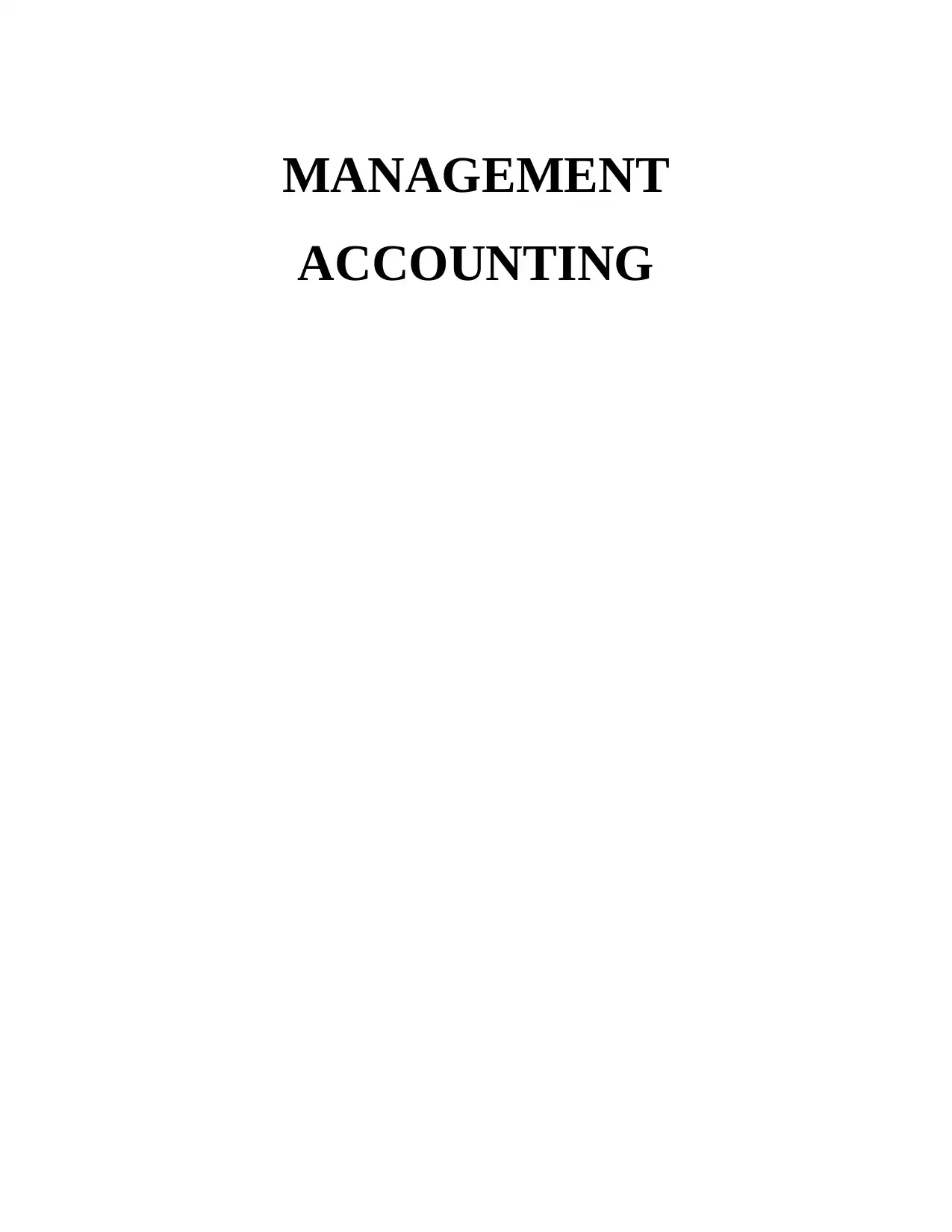
MANAGEMENT
ACCOUNTING
ACCOUNTING
Secure Best Marks with AI Grader
Need help grading? Try our AI Grader for instant feedback on your assignments.
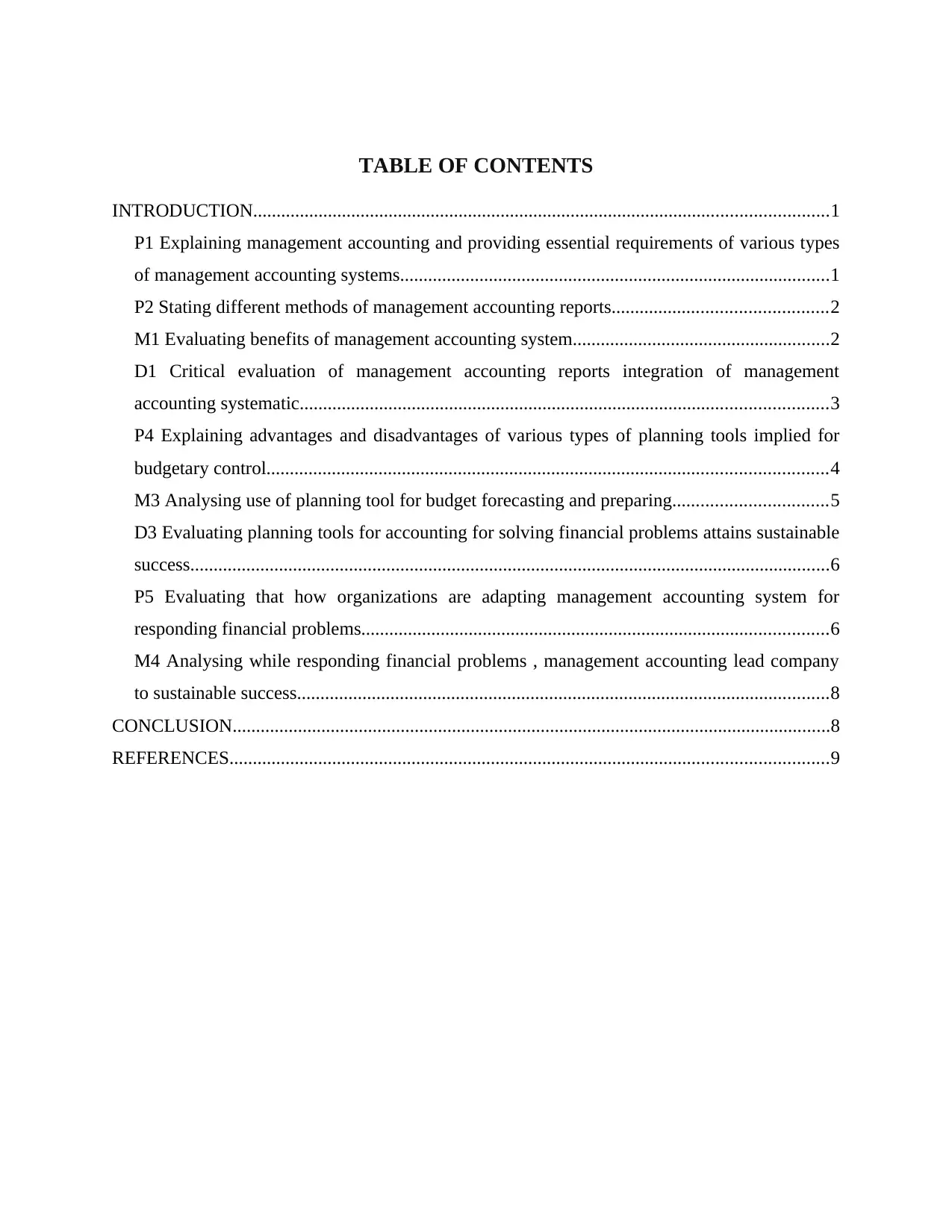
TABLE OF CONTENTS
INTRODUCTION...........................................................................................................................1
P1 Explaining management accounting and providing essential requirements of various types
of management accounting systems............................................................................................1
P2 Stating different methods of management accounting reports..............................................2
M1 Evaluating benefits of management accounting system.......................................................2
D1 Critical evaluation of management accounting reports integration of management
accounting systematic.................................................................................................................3
P4 Explaining advantages and disadvantages of various types of planning tools implied for
budgetary control........................................................................................................................4
M3 Analysing use of planning tool for budget forecasting and preparing.................................5
D3 Evaluating planning tools for accounting for solving financial problems attains sustainable
success.........................................................................................................................................6
P5 Evaluating that how organizations are adapting management accounting system for
responding financial problems....................................................................................................6
M4 Analysing while responding financial problems , management accounting lead company
to sustainable success..................................................................................................................8
CONCLUSION................................................................................................................................8
REFERENCES................................................................................................................................9
INTRODUCTION...........................................................................................................................1
P1 Explaining management accounting and providing essential requirements of various types
of management accounting systems............................................................................................1
P2 Stating different methods of management accounting reports..............................................2
M1 Evaluating benefits of management accounting system.......................................................2
D1 Critical evaluation of management accounting reports integration of management
accounting systematic.................................................................................................................3
P4 Explaining advantages and disadvantages of various types of planning tools implied for
budgetary control........................................................................................................................4
M3 Analysing use of planning tool for budget forecasting and preparing.................................5
D3 Evaluating planning tools for accounting for solving financial problems attains sustainable
success.........................................................................................................................................6
P5 Evaluating that how organizations are adapting management accounting system for
responding financial problems....................................................................................................6
M4 Analysing while responding financial problems , management accounting lead company
to sustainable success..................................................................................................................8
CONCLUSION................................................................................................................................8
REFERENCES................................................................................................................................9
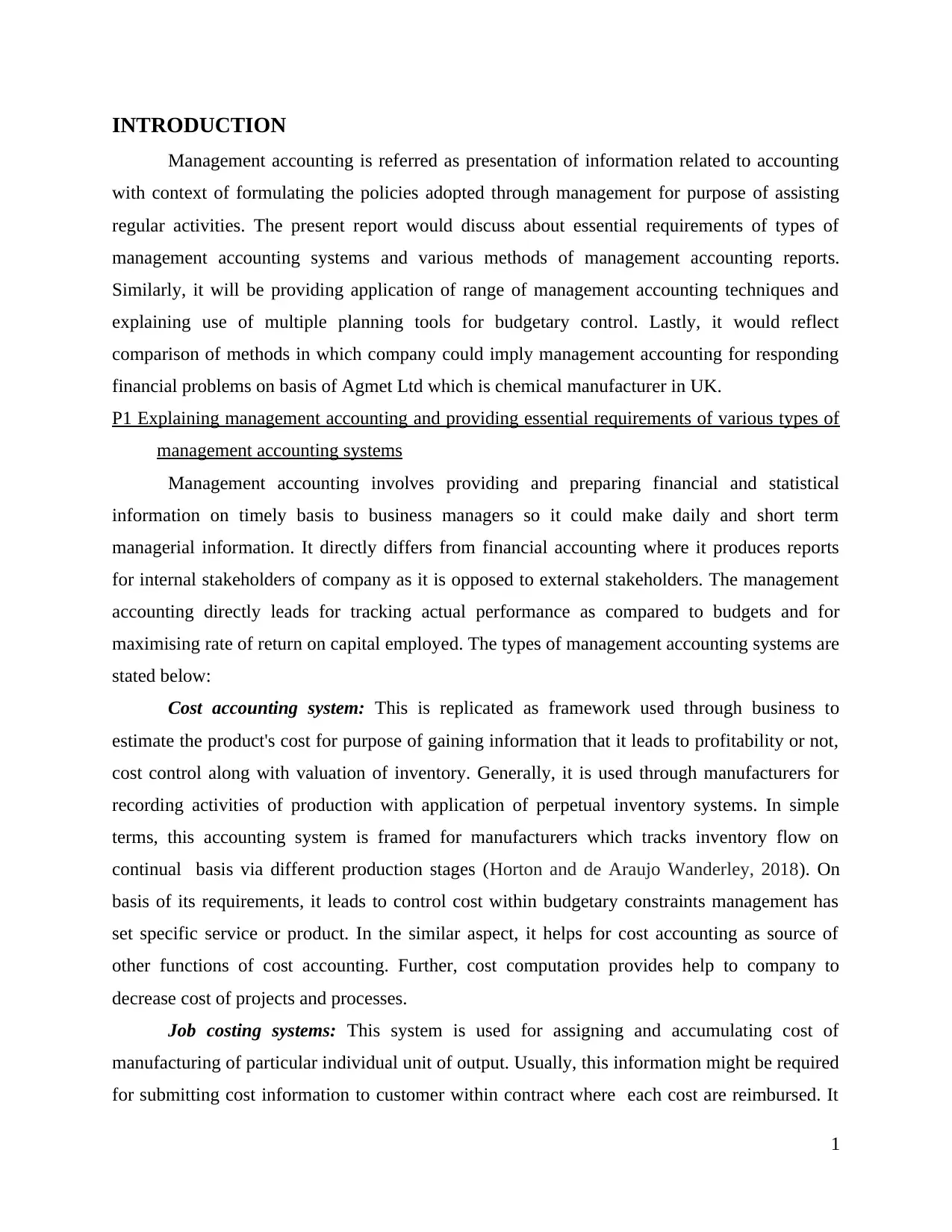
INTRODUCTION
Management accounting is referred as presentation of information related to accounting
with context of formulating the policies adopted through management for purpose of assisting
regular activities. The present report would discuss about essential requirements of types of
management accounting systems and various methods of management accounting reports.
Similarly, it will be providing application of range of management accounting techniques and
explaining use of multiple planning tools for budgetary control. Lastly, it would reflect
comparison of methods in which company could imply management accounting for responding
financial problems on basis of Agmet Ltd which is chemical manufacturer in UK.
P1 Explaining management accounting and providing essential requirements of various types of
management accounting systems
Management accounting involves providing and preparing financial and statistical
information on timely basis to business managers so it could make daily and short term
managerial information. It directly differs from financial accounting where it produces reports
for internal stakeholders of company as it is opposed to external stakeholders. The management
accounting directly leads for tracking actual performance as compared to budgets and for
maximising rate of return on capital employed. The types of management accounting systems are
stated below:
Cost accounting system: This is replicated as framework used through business to
estimate the product's cost for purpose of gaining information that it leads to profitability or not,
cost control along with valuation of inventory. Generally, it is used through manufacturers for
recording activities of production with application of perpetual inventory systems. In simple
terms, this accounting system is framed for manufacturers which tracks inventory flow on
continual basis via different production stages (Horton and de Araujo Wanderley, 2018). On
basis of its requirements, it leads to control cost within budgetary constraints management has
set specific service or product. In the similar aspect, it helps for cost accounting as source of
other functions of cost accounting. Further, cost computation provides help to company to
decrease cost of projects and processes.
Job costing systems: This system is used for assigning and accumulating cost of
manufacturing of particular individual unit of output. Usually, this information might be required
for submitting cost information to customer within contract where each cost are reimbursed. It
1
Management accounting is referred as presentation of information related to accounting
with context of formulating the policies adopted through management for purpose of assisting
regular activities. The present report would discuss about essential requirements of types of
management accounting systems and various methods of management accounting reports.
Similarly, it will be providing application of range of management accounting techniques and
explaining use of multiple planning tools for budgetary control. Lastly, it would reflect
comparison of methods in which company could imply management accounting for responding
financial problems on basis of Agmet Ltd which is chemical manufacturer in UK.
P1 Explaining management accounting and providing essential requirements of various types of
management accounting systems
Management accounting involves providing and preparing financial and statistical
information on timely basis to business managers so it could make daily and short term
managerial information. It directly differs from financial accounting where it produces reports
for internal stakeholders of company as it is opposed to external stakeholders. The management
accounting directly leads for tracking actual performance as compared to budgets and for
maximising rate of return on capital employed. The types of management accounting systems are
stated below:
Cost accounting system: This is replicated as framework used through business to
estimate the product's cost for purpose of gaining information that it leads to profitability or not,
cost control along with valuation of inventory. Generally, it is used through manufacturers for
recording activities of production with application of perpetual inventory systems. In simple
terms, this accounting system is framed for manufacturers which tracks inventory flow on
continual basis via different production stages (Horton and de Araujo Wanderley, 2018). On
basis of its requirements, it leads to control cost within budgetary constraints management has
set specific service or product. In the similar aspect, it helps for cost accounting as source of
other functions of cost accounting. Further, cost computation provides help to company to
decrease cost of projects and processes.
Job costing systems: This system is used for assigning and accumulating cost of
manufacturing of particular individual unit of output. Usually, this information might be required
for submitting cost information to customer within contract where each cost are reimbursed. It
1
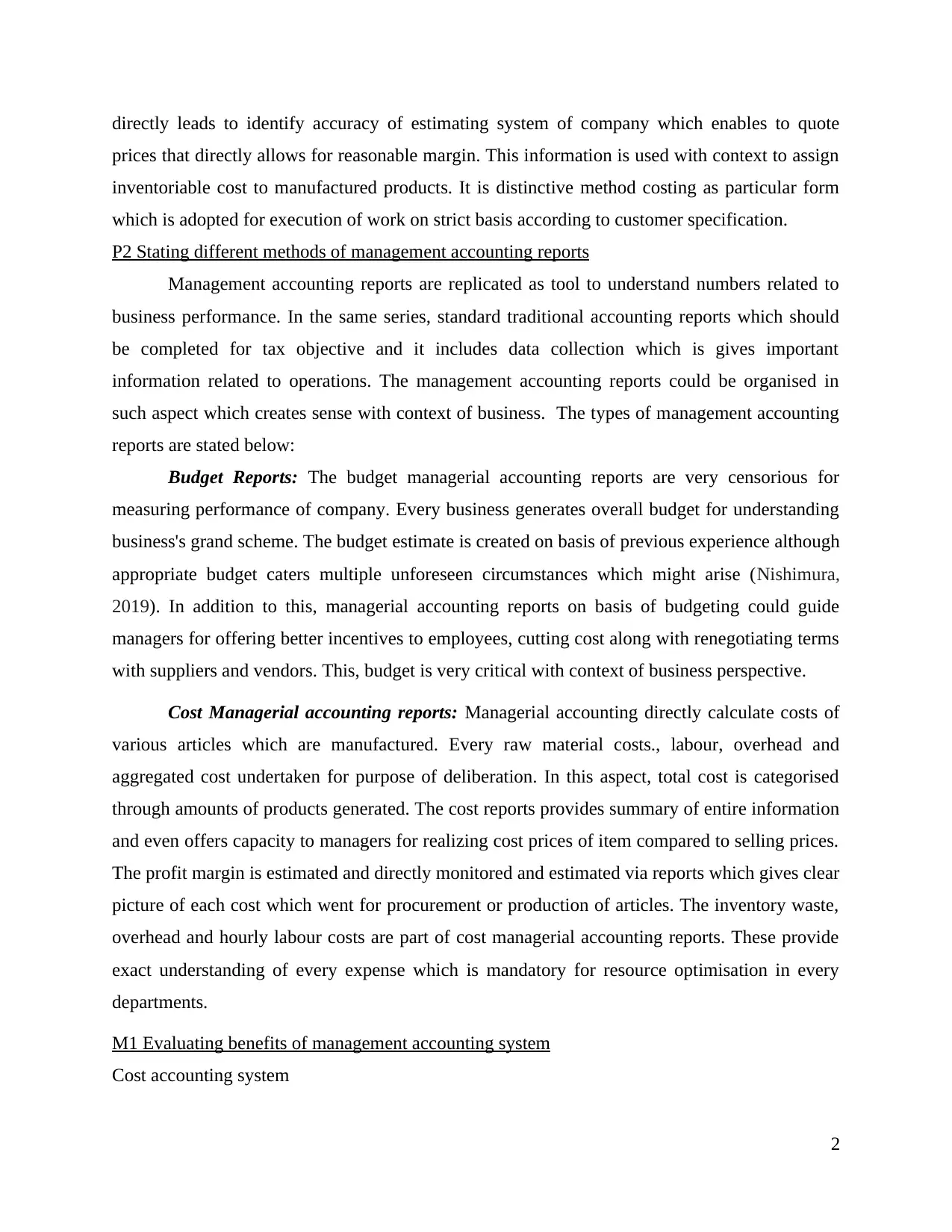
directly leads to identify accuracy of estimating system of company which enables to quote
prices that directly allows for reasonable margin. This information is used with context to assign
inventoriable cost to manufactured products. It is distinctive method costing as particular form
which is adopted for execution of work on strict basis according to customer specification.
P2 Stating different methods of management accounting reports
Management accounting reports are replicated as tool to understand numbers related to
business performance. In the same series, standard traditional accounting reports which should
be completed for tax objective and it includes data collection which is gives important
information related to operations. The management accounting reports could be organised in
such aspect which creates sense with context of business. The types of management accounting
reports are stated below:
Budget Reports: The budget managerial accounting reports are very censorious for
measuring performance of company. Every business generates overall budget for understanding
business's grand scheme. The budget estimate is created on basis of previous experience although
appropriate budget caters multiple unforeseen circumstances which might arise (Nishimura,
2019). In addition to this, managerial accounting reports on basis of budgeting could guide
managers for offering better incentives to employees, cutting cost along with renegotiating terms
with suppliers and vendors. This, budget is very critical with context of business perspective.
Cost Managerial accounting reports: Managerial accounting directly calculate costs of
various articles which are manufactured. Every raw material costs., labour, overhead and
aggregated cost undertaken for purpose of deliberation. In this aspect, total cost is categorised
through amounts of products generated. The cost reports provides summary of entire information
and even offers capacity to managers for realizing cost prices of item compared to selling prices.
The profit margin is estimated and directly monitored and estimated via reports which gives clear
picture of each cost which went for procurement or production of articles. The inventory waste,
overhead and hourly labour costs are part of cost managerial accounting reports. These provide
exact understanding of every expense which is mandatory for resource optimisation in every
departments.
M1 Evaluating benefits of management accounting system
Cost accounting system
2
prices that directly allows for reasonable margin. This information is used with context to assign
inventoriable cost to manufactured products. It is distinctive method costing as particular form
which is adopted for execution of work on strict basis according to customer specification.
P2 Stating different methods of management accounting reports
Management accounting reports are replicated as tool to understand numbers related to
business performance. In the same series, standard traditional accounting reports which should
be completed for tax objective and it includes data collection which is gives important
information related to operations. The management accounting reports could be organised in
such aspect which creates sense with context of business. The types of management accounting
reports are stated below:
Budget Reports: The budget managerial accounting reports are very censorious for
measuring performance of company. Every business generates overall budget for understanding
business's grand scheme. The budget estimate is created on basis of previous experience although
appropriate budget caters multiple unforeseen circumstances which might arise (Nishimura,
2019). In addition to this, managerial accounting reports on basis of budgeting could guide
managers for offering better incentives to employees, cutting cost along with renegotiating terms
with suppliers and vendors. This, budget is very critical with context of business perspective.
Cost Managerial accounting reports: Managerial accounting directly calculate costs of
various articles which are manufactured. Every raw material costs., labour, overhead and
aggregated cost undertaken for purpose of deliberation. In this aspect, total cost is categorised
through amounts of products generated. The cost reports provides summary of entire information
and even offers capacity to managers for realizing cost prices of item compared to selling prices.
The profit margin is estimated and directly monitored and estimated via reports which gives clear
picture of each cost which went for procurement or production of articles. The inventory waste,
overhead and hourly labour costs are part of cost managerial accounting reports. These provide
exact understanding of every expense which is mandatory for resource optimisation in every
departments.
M1 Evaluating benefits of management accounting system
Cost accounting system
2
Paraphrase This Document
Need a fresh take? Get an instant paraphrase of this document with our AI Paraphraser
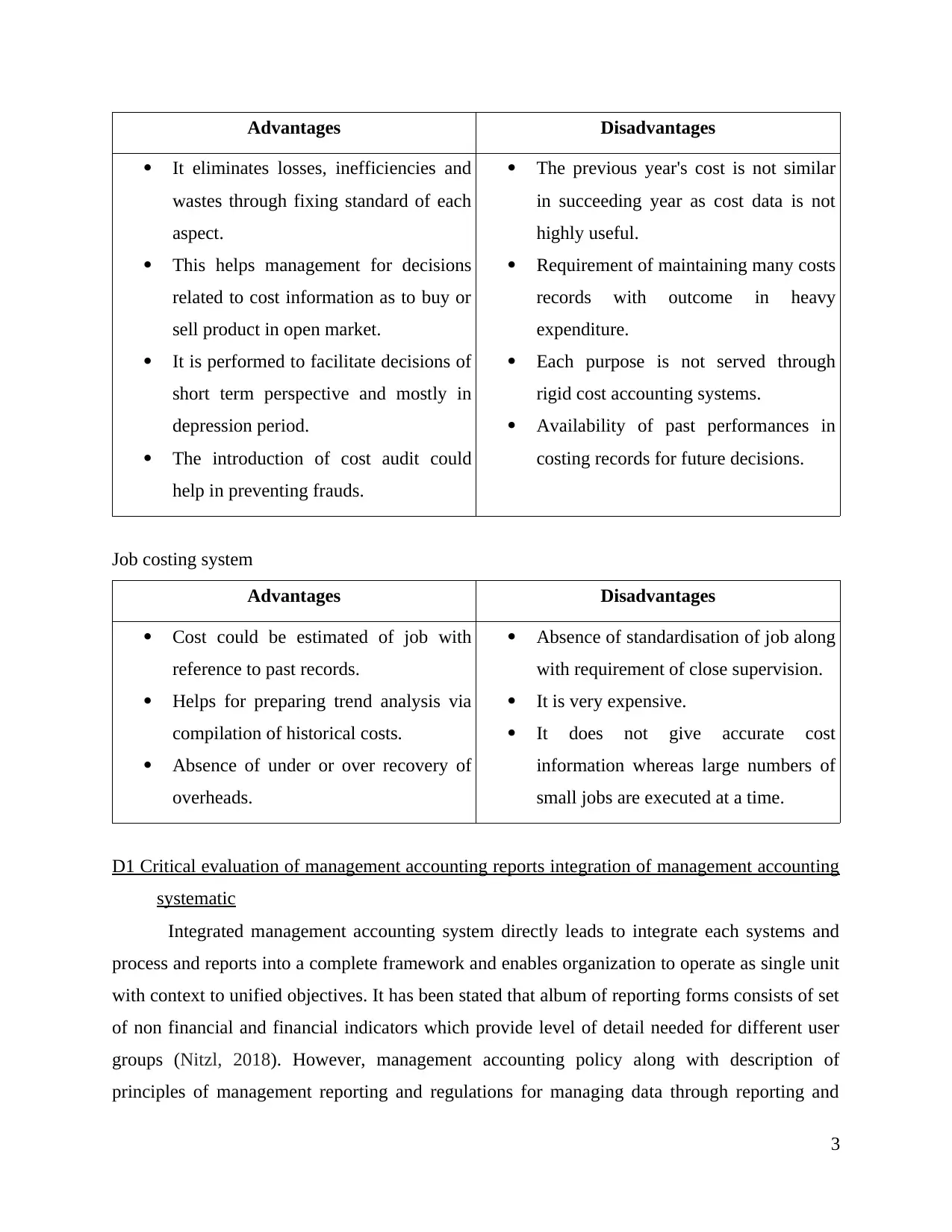
Advantages Disadvantages
It eliminates losses, inefficiencies and
wastes through fixing standard of each
aspect.
This helps management for decisions
related to cost information as to buy or
sell product in open market.
It is performed to facilitate decisions of
short term perspective and mostly in
depression period.
The introduction of cost audit could
help in preventing frauds.
The previous year's cost is not similar
in succeeding year as cost data is not
highly useful.
Requirement of maintaining many costs
records with outcome in heavy
expenditure.
Each purpose is not served through
rigid cost accounting systems.
Availability of past performances in
costing records for future decisions.
Job costing system
Advantages Disadvantages
Cost could be estimated of job with
reference to past records.
Helps for preparing trend analysis via
compilation of historical costs.
Absence of under or over recovery of
overheads.
Absence of standardisation of job along
with requirement of close supervision.
It is very expensive.
It does not give accurate cost
information whereas large numbers of
small jobs are executed at a time.
D1 Critical evaluation of management accounting reports integration of management accounting
systematic
Integrated management accounting system directly leads to integrate each systems and
process and reports into a complete framework and enables organization to operate as single unit
with context to unified objectives. It has been stated that album of reporting forms consists of set
of non financial and financial indicators which provide level of detail needed for different user
groups (Nitzl, 2018). However, management accounting policy along with description of
principles of management reporting and regulations for managing data through reporting and
3
It eliminates losses, inefficiencies and
wastes through fixing standard of each
aspect.
This helps management for decisions
related to cost information as to buy or
sell product in open market.
It is performed to facilitate decisions of
short term perspective and mostly in
depression period.
The introduction of cost audit could
help in preventing frauds.
The previous year's cost is not similar
in succeeding year as cost data is not
highly useful.
Requirement of maintaining many costs
records with outcome in heavy
expenditure.
Each purpose is not served through
rigid cost accounting systems.
Availability of past performances in
costing records for future decisions.
Job costing system
Advantages Disadvantages
Cost could be estimated of job with
reference to past records.
Helps for preparing trend analysis via
compilation of historical costs.
Absence of under or over recovery of
overheads.
Absence of standardisation of job along
with requirement of close supervision.
It is very expensive.
It does not give accurate cost
information whereas large numbers of
small jobs are executed at a time.
D1 Critical evaluation of management accounting reports integration of management accounting
systematic
Integrated management accounting system directly leads to integrate each systems and
process and reports into a complete framework and enables organization to operate as single unit
with context to unified objectives. It has been stated that album of reporting forms consists of set
of non financial and financial indicators which provide level of detail needed for different user
groups (Nitzl, 2018). However, management accounting policy along with description of
principles of management reporting and regulations for managing data through reporting and
3
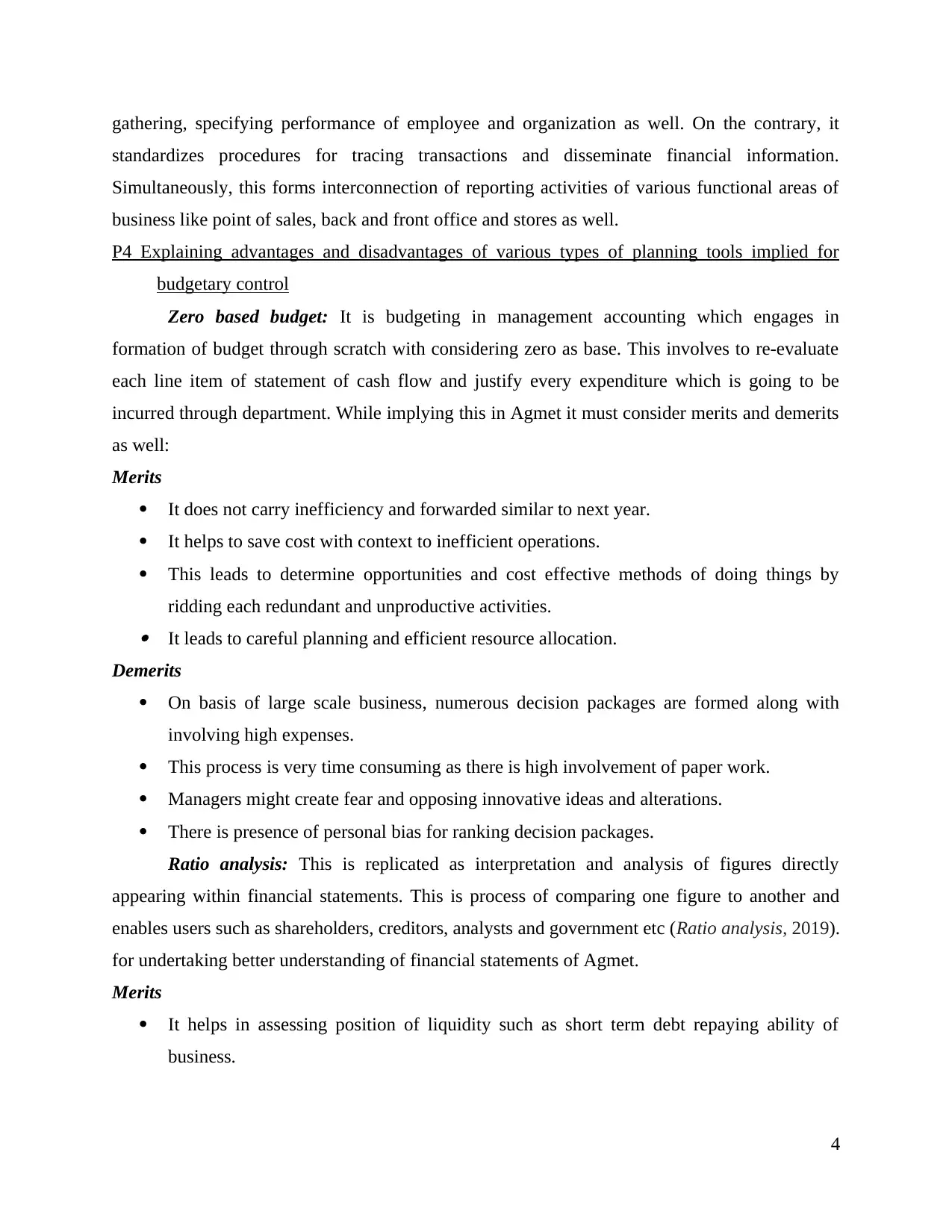
gathering, specifying performance of employee and organization as well. On the contrary, it
standardizes procedures for tracing transactions and disseminate financial information.
Simultaneously, this forms interconnection of reporting activities of various functional areas of
business like point of sales, back and front office and stores as well.
P4 Explaining advantages and disadvantages of various types of planning tools implied for
budgetary control
Zero based budget: It is budgeting in management accounting which engages in
formation of budget through scratch with considering zero as base. This involves to re-evaluate
each line item of statement of cash flow and justify every expenditure which is going to be
incurred through department. While implying this in Agmet it must consider merits and demerits
as well:
Merits
It does not carry inefficiency and forwarded similar to next year.
It helps to save cost with context to inefficient operations.
This leads to determine opportunities and cost effective methods of doing things by
ridding each redundant and unproductive activities. It leads to careful planning and efficient resource allocation.
Demerits
On basis of large scale business, numerous decision packages are formed along with
involving high expenses.
This process is very time consuming as there is high involvement of paper work.
Managers might create fear and opposing innovative ideas and alterations.
There is presence of personal bias for ranking decision packages.
Ratio analysis: This is replicated as interpretation and analysis of figures directly
appearing within financial statements. This is process of comparing one figure to another and
enables users such as shareholders, creditors, analysts and government etc (Ratio analysis, 2019).
for undertaking better understanding of financial statements of Agmet.
Merits
It helps in assessing position of liquidity such as short term debt repaying ability of
business.
4
standardizes procedures for tracing transactions and disseminate financial information.
Simultaneously, this forms interconnection of reporting activities of various functional areas of
business like point of sales, back and front office and stores as well.
P4 Explaining advantages and disadvantages of various types of planning tools implied for
budgetary control
Zero based budget: It is budgeting in management accounting which engages in
formation of budget through scratch with considering zero as base. This involves to re-evaluate
each line item of statement of cash flow and justify every expenditure which is going to be
incurred through department. While implying this in Agmet it must consider merits and demerits
as well:
Merits
It does not carry inefficiency and forwarded similar to next year.
It helps to save cost with context to inefficient operations.
This leads to determine opportunities and cost effective methods of doing things by
ridding each redundant and unproductive activities. It leads to careful planning and efficient resource allocation.
Demerits
On basis of large scale business, numerous decision packages are formed along with
involving high expenses.
This process is very time consuming as there is high involvement of paper work.
Managers might create fear and opposing innovative ideas and alterations.
There is presence of personal bias for ranking decision packages.
Ratio analysis: This is replicated as interpretation and analysis of figures directly
appearing within financial statements. This is process of comparing one figure to another and
enables users such as shareholders, creditors, analysts and government etc (Ratio analysis, 2019).
for undertaking better understanding of financial statements of Agmet.
Merits
It helps in assessing position of liquidity such as short term debt repaying ability of
business.
4

It is used for controlling performances of various departments or division undertaking
along with cost control.
It indicates degree of efficiency in management along with appropriate utilisation of its
assets. These are effective mode of communication and plays vital role to inform position of
progress made through concern of business to other parties and owners.
Demerits
These are calculated through historical information traced in financial statements and
does not reflect present conditions.
Multiple accounting policies on basis of inventory valuation, charging depreciation and
making accounting data and accounting ratios of two business non-comparable.
This tool is used for only quantitative analysis whereas qualitative factors are avoided
during ratio computation (Richards and et.al., 2019).
Ratios account for single variable as they could not provide appropriate picture since
multiple other variables like economic conditions, resource availability, government
policy etc. must be kept in mind during ratio interpretation.
M3 Analysing use of planning tool for budget forecasting and preparing
Particulars Jan Feb Mar Apr May Jun Jul Aug Sep Oct Nov Dec
Cash inflows
Opening inflow of
cash 5000 6425 8807
1127
1
1381
6
1644
3
1915
1
2194
0
2480
9
2775
7
3078
4
3388
9
Total sales
revenue
1000
0
1020
0
1040
4
1061
2
1082
4
1104
1
1126
2
1148
7
1171
7
1195
1
1219
0
1243
4
Other income 2000 2000 2000 2000 2000 2000 2000 2000 2000 2000 2000 2000
Total cash
inflows
1700
0
1862
5
2121
1
2388
3
2664
1
2948
4
3241
3
3542
7
3852
6
4170
8
4497
4
4832
3
Cash outflows
Direct material 2375 1530 1561 1592 1624 1656 1689 1723 1757 1793 1828 1865
5
along with cost control.
It indicates degree of efficiency in management along with appropriate utilisation of its
assets. These are effective mode of communication and plays vital role to inform position of
progress made through concern of business to other parties and owners.
Demerits
These are calculated through historical information traced in financial statements and
does not reflect present conditions.
Multiple accounting policies on basis of inventory valuation, charging depreciation and
making accounting data and accounting ratios of two business non-comparable.
This tool is used for only quantitative analysis whereas qualitative factors are avoided
during ratio computation (Richards and et.al., 2019).
Ratios account for single variable as they could not provide appropriate picture since
multiple other variables like economic conditions, resource availability, government
policy etc. must be kept in mind during ratio interpretation.
M3 Analysing use of planning tool for budget forecasting and preparing
Particulars Jan Feb Mar Apr May Jun Jul Aug Sep Oct Nov Dec
Cash inflows
Opening inflow of
cash 5000 6425 8807
1127
1
1381
6
1644
3
1915
1
2194
0
2480
9
2775
7
3078
4
3388
9
Total sales
revenue
1000
0
1020
0
1040
4
1061
2
1082
4
1104
1
1126
2
1148
7
1171
7
1195
1
1219
0
1243
4
Other income 2000 2000 2000 2000 2000 2000 2000 2000 2000 2000 2000 2000
Total cash
inflows
1700
0
1862
5
2121
1
2388
3
2664
1
2948
4
3241
3
3542
7
3852
6
4170
8
4497
4
4832
3
Cash outflows
Direct material 2375 1530 1561 1592 1624 1656 1689 1723 1757 1793 1828 1865
5
Secure Best Marks with AI Grader
Need help grading? Try our AI Grader for instant feedback on your assignments.
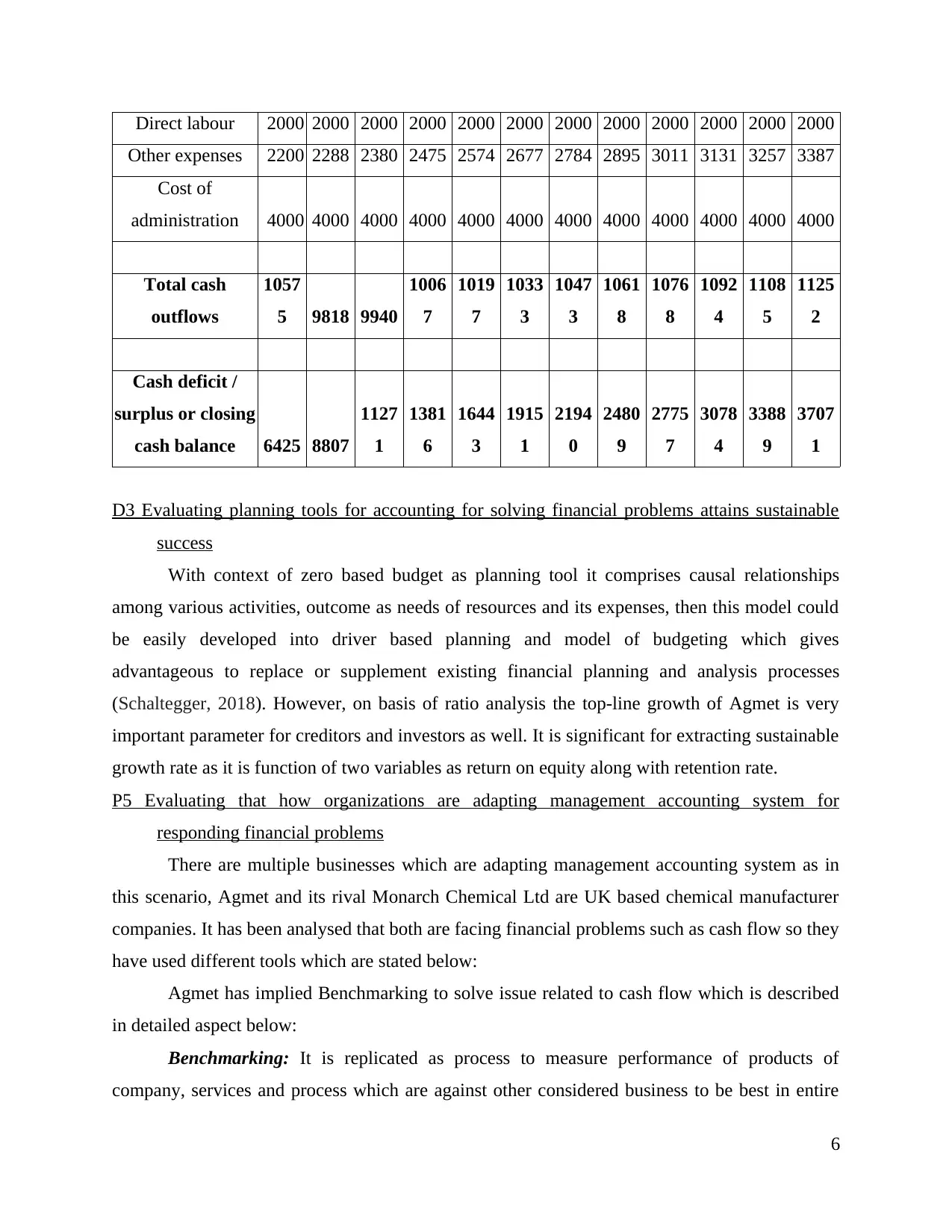
Direct labour 2000 2000 2000 2000 2000 2000 2000 2000 2000 2000 2000 2000
Other expenses 2200 2288 2380 2475 2574 2677 2784 2895 3011 3131 3257 3387
Cost of
administration 4000 4000 4000 4000 4000 4000 4000 4000 4000 4000 4000 4000
Total cash
outflows
1057
5 9818 9940
1006
7
1019
7
1033
3
1047
3
1061
8
1076
8
1092
4
1108
5
1125
2
Cash deficit /
surplus or closing
cash balance 6425 8807
1127
1
1381
6
1644
3
1915
1
2194
0
2480
9
2775
7
3078
4
3388
9
3707
1
D3 Evaluating planning tools for accounting for solving financial problems attains sustainable
success
With context of zero based budget as planning tool it comprises causal relationships
among various activities, outcome as needs of resources and its expenses, then this model could
be easily developed into driver based planning and model of budgeting which gives
advantageous to replace or supplement existing financial planning and analysis processes
(Schaltegger, 2018). However, on basis of ratio analysis the top-line growth of Agmet is very
important parameter for creditors and investors as well. It is significant for extracting sustainable
growth rate as it is function of two variables as return on equity along with retention rate.
P5 Evaluating that how organizations are adapting management accounting system for
responding financial problems
There are multiple businesses which are adapting management accounting system as in
this scenario, Agmet and its rival Monarch Chemical Ltd are UK based chemical manufacturer
companies. It has been analysed that both are facing financial problems such as cash flow so they
have used different tools which are stated below:
Agmet has implied Benchmarking to solve issue related to cash flow which is described
in detailed aspect below:
Benchmarking: It is replicated as process to measure performance of products of
company, services and process which are against other considered business to be best in entire
6
Other expenses 2200 2288 2380 2475 2574 2677 2784 2895 3011 3131 3257 3387
Cost of
administration 4000 4000 4000 4000 4000 4000 4000 4000 4000 4000 4000 4000
Total cash
outflows
1057
5 9818 9940
1006
7
1019
7
1033
3
1047
3
1061
8
1076
8
1092
4
1108
5
1125
2
Cash deficit /
surplus or closing
cash balance 6425 8807
1127
1
1381
6
1644
3
1915
1
2194
0
2480
9
2775
7
3078
4
3388
9
3707
1
D3 Evaluating planning tools for accounting for solving financial problems attains sustainable
success
With context of zero based budget as planning tool it comprises causal relationships
among various activities, outcome as needs of resources and its expenses, then this model could
be easily developed into driver based planning and model of budgeting which gives
advantageous to replace or supplement existing financial planning and analysis processes
(Schaltegger, 2018). However, on basis of ratio analysis the top-line growth of Agmet is very
important parameter for creditors and investors as well. It is significant for extracting sustainable
growth rate as it is function of two variables as return on equity along with retention rate.
P5 Evaluating that how organizations are adapting management accounting system for
responding financial problems
There are multiple businesses which are adapting management accounting system as in
this scenario, Agmet and its rival Monarch Chemical Ltd are UK based chemical manufacturer
companies. It has been analysed that both are facing financial problems such as cash flow so they
have used different tools which are stated below:
Agmet has implied Benchmarking to solve issue related to cash flow which is described
in detailed aspect below:
Benchmarking: It is replicated as process to measure performance of products of
company, services and process which are against other considered business to be best in entire
6
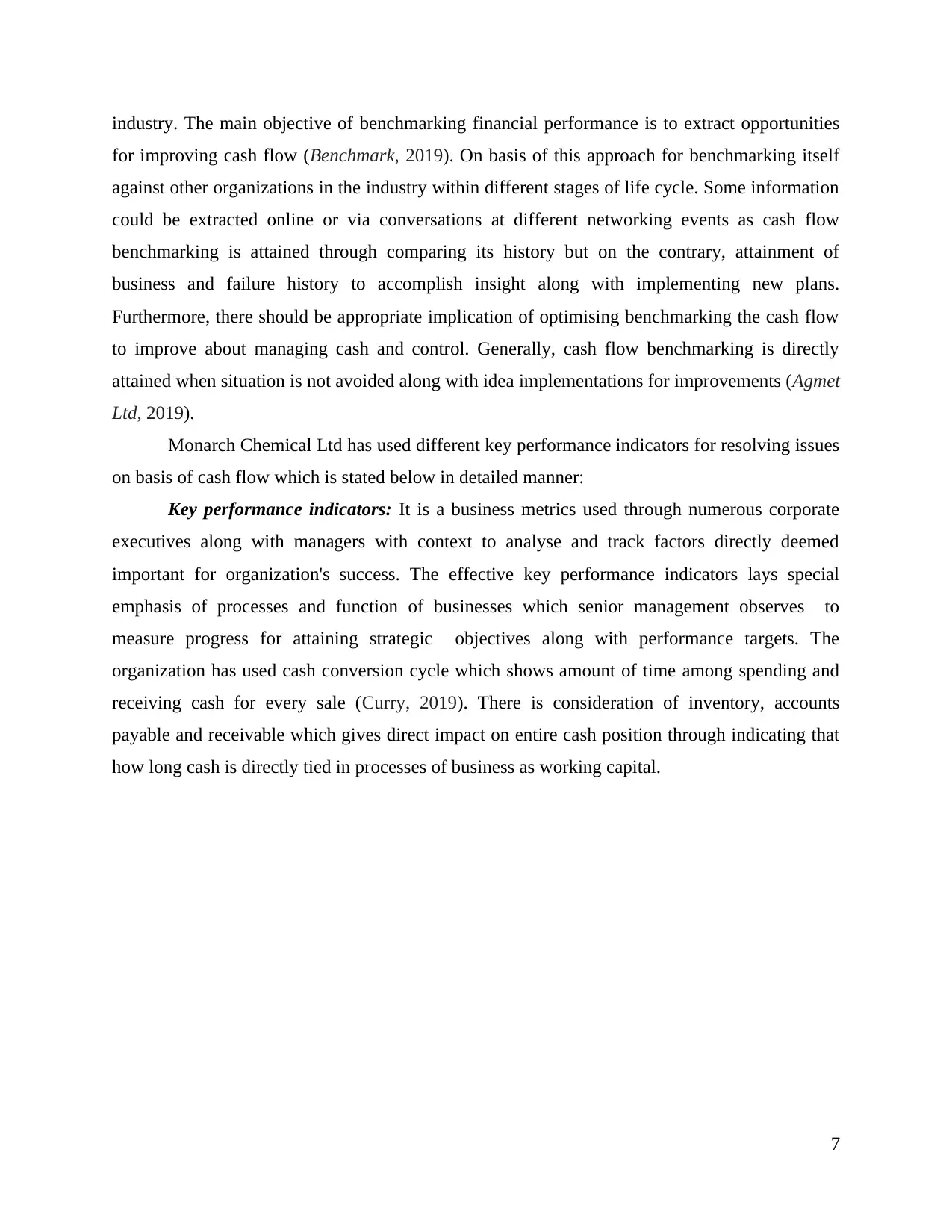
industry. The main objective of benchmarking financial performance is to extract opportunities
for improving cash flow (Benchmark, 2019). On basis of this approach for benchmarking itself
against other organizations in the industry within different stages of life cycle. Some information
could be extracted online or via conversations at different networking events as cash flow
benchmarking is attained through comparing its history but on the contrary, attainment of
business and failure history to accomplish insight along with implementing new plans.
Furthermore, there should be appropriate implication of optimising benchmarking the cash flow
to improve about managing cash and control. Generally, cash flow benchmarking is directly
attained when situation is not avoided along with idea implementations for improvements (Agmet
Ltd, 2019).
Monarch Chemical Ltd has used different key performance indicators for resolving issues
on basis of cash flow which is stated below in detailed manner:
Key performance indicators: It is a business metrics used through numerous corporate
executives along with managers with context to analyse and track factors directly deemed
important for organization's success. The effective key performance indicators lays special
emphasis of processes and function of businesses which senior management observes to
measure progress for attaining strategic objectives along with performance targets. The
organization has used cash conversion cycle which shows amount of time among spending and
receiving cash for every sale (Curry, 2019). There is consideration of inventory, accounts
payable and receivable which gives direct impact on entire cash position through indicating that
how long cash is directly tied in processes of business as working capital.
7
for improving cash flow (Benchmark, 2019). On basis of this approach for benchmarking itself
against other organizations in the industry within different stages of life cycle. Some information
could be extracted online or via conversations at different networking events as cash flow
benchmarking is attained through comparing its history but on the contrary, attainment of
business and failure history to accomplish insight along with implementing new plans.
Furthermore, there should be appropriate implication of optimising benchmarking the cash flow
to improve about managing cash and control. Generally, cash flow benchmarking is directly
attained when situation is not avoided along with idea implementations for improvements (Agmet
Ltd, 2019).
Monarch Chemical Ltd has used different key performance indicators for resolving issues
on basis of cash flow which is stated below in detailed manner:
Key performance indicators: It is a business metrics used through numerous corporate
executives along with managers with context to analyse and track factors directly deemed
important for organization's success. The effective key performance indicators lays special
emphasis of processes and function of businesses which senior management observes to
measure progress for attaining strategic objectives along with performance targets. The
organization has used cash conversion cycle which shows amount of time among spending and
receiving cash for every sale (Curry, 2019). There is consideration of inventory, accounts
payable and receivable which gives direct impact on entire cash position through indicating that
how long cash is directly tied in processes of business as working capital.
7
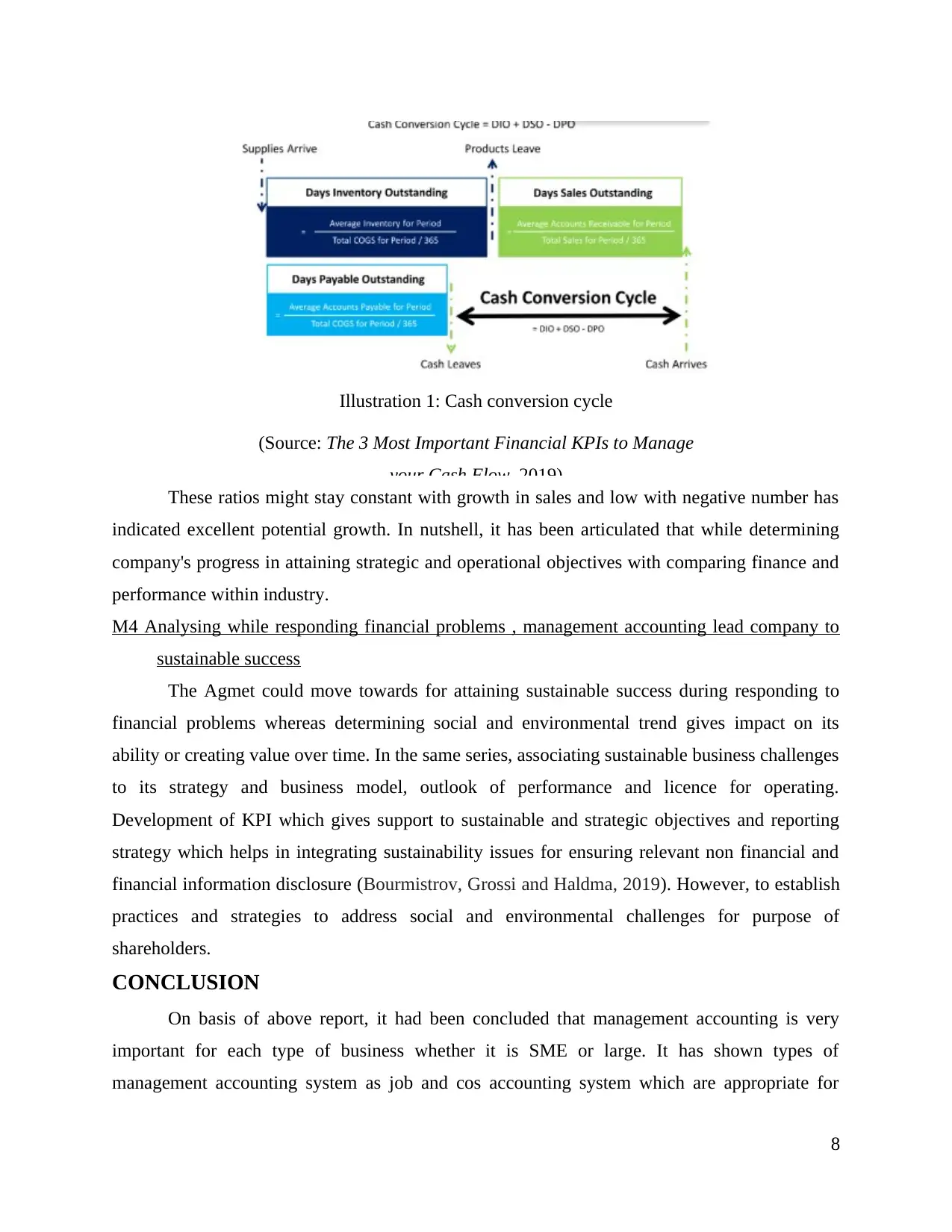
Illustration 1: Cash conversion cycle
(Source: The 3 Most Important Financial KPIs to Manage
your Cash Flow, 2019)
These ratios might stay constant with growth in sales and low with negative number has
indicated excellent potential growth. In nutshell, it has been articulated that while determining
company's progress in attaining strategic and operational objectives with comparing finance and
performance within industry.
M4 Analysing while responding financial problems , management accounting lead company to
sustainable success
The Agmet could move towards for attaining sustainable success during responding to
financial problems whereas determining social and environmental trend gives impact on its
ability or creating value over time. In the same series, associating sustainable business challenges
to its strategy and business model, outlook of performance and licence for operating.
Development of KPI which gives support to sustainable and strategic objectives and reporting
strategy which helps in integrating sustainability issues for ensuring relevant non financial and
financial information disclosure (Bourmistrov, Grossi and Haldma, 2019). However, to establish
practices and strategies to address social and environmental challenges for purpose of
shareholders.
CONCLUSION
On basis of above report, it had been concluded that management accounting is very
important for each type of business whether it is SME or large. It has shown types of
management accounting system as job and cos accounting system which are appropriate for
8
(Source: The 3 Most Important Financial KPIs to Manage
your Cash Flow, 2019)
These ratios might stay constant with growth in sales and low with negative number has
indicated excellent potential growth. In nutshell, it has been articulated that while determining
company's progress in attaining strategic and operational objectives with comparing finance and
performance within industry.
M4 Analysing while responding financial problems , management accounting lead company to
sustainable success
The Agmet could move towards for attaining sustainable success during responding to
financial problems whereas determining social and environmental trend gives impact on its
ability or creating value over time. In the same series, associating sustainable business challenges
to its strategy and business model, outlook of performance and licence for operating.
Development of KPI which gives support to sustainable and strategic objectives and reporting
strategy which helps in integrating sustainability issues for ensuring relevant non financial and
financial information disclosure (Bourmistrov, Grossi and Haldma, 2019). However, to establish
practices and strategies to address social and environmental challenges for purpose of
shareholders.
CONCLUSION
On basis of above report, it had been concluded that management accounting is very
important for each type of business whether it is SME or large. It has shown types of
management accounting system as job and cos accounting system which are appropriate for
8
Paraphrase This Document
Need a fresh take? Get an instant paraphrase of this document with our AI Paraphraser

Agmet. Moreover, it has shown planning tools such as zero based budget and ratio analysis
which are implied in management accounting. Thus, it had concluded with adaption of
management accounting system to respond financial problems.
9
which are implied in management accounting. Thus, it had concluded with adaption of
management accounting system to respond financial problems.
9
1 out of 11
Related Documents
Your All-in-One AI-Powered Toolkit for Academic Success.
+13062052269
info@desklib.com
Available 24*7 on WhatsApp / Email
![[object Object]](/_next/static/media/star-bottom.7253800d.svg)
Unlock your academic potential
© 2024 | Zucol Services PVT LTD | All rights reserved.





